 France (1907): Edgar Quinet, Waldeck-Rousseau
France (1907): Edgar Quinet, Waldeck-RousseauWW1 French Cruisers
Sfax | Tage | Amiral Cecille | D'Iberville class | Dunois class | Foudre | Davout | Suchet | Forbin class | Troude class | Alger class | Friant class | Linois class | Descartes class | D'Assas class | D’Entrecasteaux | Protet class | Guichen | Chateaurenault | Chateaurenault | D'Estrées class | Jurien de la Graviere | Lamotte-Picquet classDupuy de Lome | Amiral Charner class | Pothuau | Jeanne d'Arc | Gueydon class | Dupleix class | Gloire class | Gambetta class | Jules Michelet | Ernest Renan | Edgar Quinet class
France’s last armoured cruisers
The last French cruiser-battleships, and by far the most imposing, were the two Edgar Quinet, which constituted at the same time a synthesis of all the acquired experience in design for this particular type of ship and at the same time an additional milestone in the genre. Laid down in 1905 and 1906 they were launched in 1907-08, completed in 1911, and had an active career lasting until the 1930s.
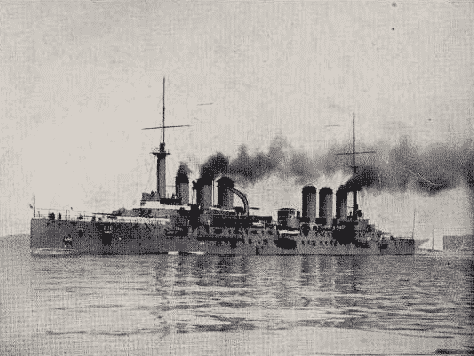
Edgar Quinet class Armoured cruisers
Development
Jeune École (Young School)’s own Admiral Ernest François Fournier strongly advocated for a fleet of armored cruisers based on the Dupuy de Lôme type back in the 1890s, for long-range commerce raiding, dealing with older battleships, and reconnaissance. Twenty-four armored cruisers followed, the Edgar-Quinet being the last, and like the previous Ernest Renan, their design was revised during construction, causing a delay in delivery. Although they had been the most powerful armored cruisers built by France, they entered service two years after the launch of the first battlecruiser, Britain's HMS Invincible, and therefore were obsolescent when accepted in service.
Indeed, because of its “semi-experimental” shipbuilding practices, France lacked many dreadnoughts and any battlecruisers, although the latter had been planned by the 1912 Durand-Viel program. This was however not that crucial as most of the French fleet had to operate in the Mediterranean against less advanced fleets, like the Austro-Hungarian Navy.
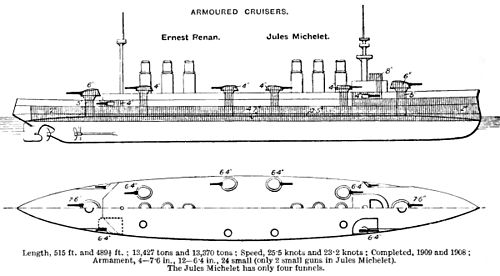
Brassey’s diagram of the previous Renan class (not one available of the Quinet)
Design
Moving 14,000 tons and 160 meters long, they were among the largest French warships in 1914. They had been largely inspired by the MN Ernest Renan (1906) but were taller and better armed, and also included a uniform artillery distribution of the monocaliber type. One of their particular features was the adoption of refrigerated ammunition holds, now a standard for French ships since the Battleship Iena explosion in 1907.
Armament
Their artillery was simplified (this was less a nightmare for supply) with the suppression of 162 mm (6.3 in) guns for a complete fourteen 193 mm (7.5 in) battery (rate of fire, up to four rpm) with only 65 mm (2.5 in) QF guns to deal with TBs. The larger guns were divided into two double turrets, six single, and four in barbettes. The 65 mm (9-pounder guns) were distributed with some in casemates and others on the superstructure. However, in 1918 the threat of aviation made for the removal of 12 guns, which were replaced by two 65 mm anti-aircraft guns and 75 mm (3.0 in) AA guns. As customary, the two armoured cruisers were given also two 450 mm (17.7 in) TTs submerged on each side of their hull.
Armor
Their armored belt was 150 mm (5.9 in), reduced to 70 mm (2.8 in) forward and 40 mm (1.6 in) aft. The lower main deck was 65 mm (2.6 in) thick while the upper deck was 30 mm (1.2 in) in thickness. Armor on the gun turrets was 200 mm (7.9 in) thick, with the barbettes at 200 mm, and casemates 194 mm, however they were linked by transverse armored bulkheads ranging from 194 mm to 120 mm (4.7 in) internally. The ship’s conning tower was 200 mm. Rousseau survived two torpedo hits thanks to an efficient cofferdam built into the lower hull, which was doubled by a longitudinal watertight bulkhead.
Propulsion
Unable to sail past 23 knots, these ships arrived when the battlecruisers introduced turbines. They had three propellers, powered by three 4-cylinder VTE (triple expansion) engines, which in turn were fed by 40 Belleville coal-fired boilers, for a total output of 36 000 hp. The boilers were truncated into six funnels in two groups of three, a common characteristic of French cruisers at that time. All of these engines were separated in watertight compartments to ensure at least partial propulsion in case of a hit to an engine room. In addition, the electrical systems aboard were fed by six electric generators. Coal capacity amounted to 2,300 t, which made for a range of 5,100 nautical miles (9,400 km; 5,900 land miles) at a moderate crusing speed (10 knots).
The Quinet class in action
Their career was very active: Together with the Renan and the Michelet, they formed the 1st light division of the Mediterranean. They patrolled in the Straits of Otranto and ensured the Austro-Hungarian blockade. Both ships covered the seizure of Corfu in January 1916.
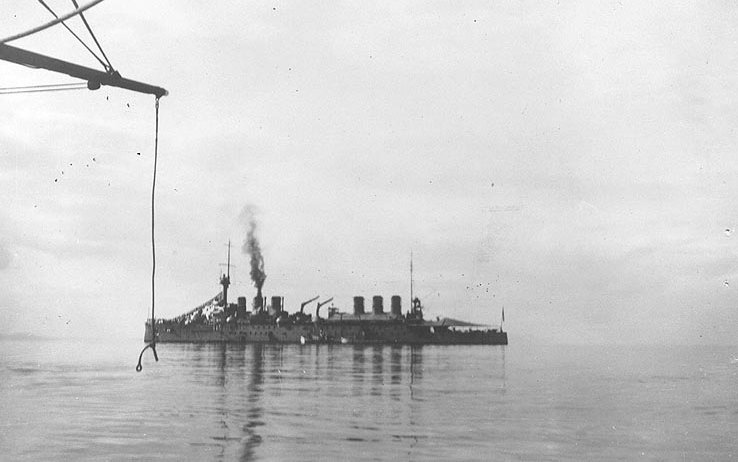
Waldeck Rousseau off Constantinople
Edgar Quinet
In August 1914 quinet took part in the pursuit of the German squadron of Admiral Souchon (SMS Goeben). She was present at the Battle of Antivari.
Quinet also carried out a rescue mission after the war of the population of Smyrna (Great Fire of Smyrna, Greek-Turkish War), embarking 1,200 civilians in 1922. In 1925-27, the Quinet underwent a complete overhaul, which made her a training ship, with a new weaponry, a new appearance, including seaplanes under shed. She hit a reef off Cape Blanc, Algeria and sank in 1930.
Waldeck-Rousseau
She served in the Adriatic and in 1914 survived two torpedo hits from Austrian U-Boats. After repairs, in October 1915 she duelled with several Austro-Hungarian destroyers. She served in the Ionian and Aegean Sea until 1918. After the war, she went to the Black Sea to support the “White” Russians under General Wrangel. On her arrival, however, she had to withstand a short-lived mutiny over poor conditions by her crew. At first, she was assigned as flagship of the Far East fleet in 1929, though she later returned to France to be disarmed in 1932. Despite this, she survived until 1941-44 when she was broken up to be sold for scrap.
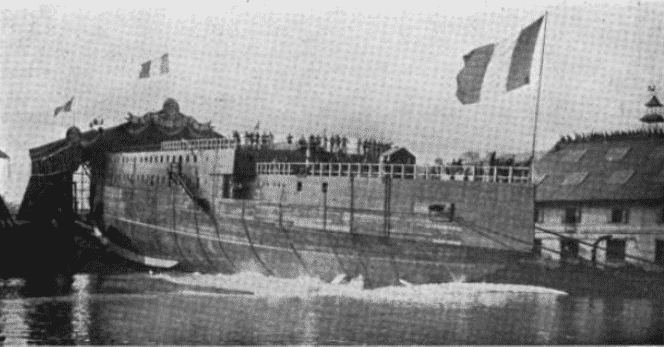
Edgar Quinet being launched
Links/sources
The Quinet class on wikipedia
Additional photos on worldnavalships.com
Combrig 1/700 Model kit review
Specs Conway’s all the world fighting ships 1906-1921.
Danton class specifications |
|
| Dimensions | 159 x 21,5 x 8,4 m |
| Displacement | 13 847 t. FL |
| Crew | 892 |
| Propulsion | 3 screws, 4 VTE engines, 40 Belleville boilers, 36,000 hp. |
| Speed | 23 knots. max. (40 km/h; 25 mph) |
| Range | 5,100 NM (9,400 km; 5,900 miles) @10 knots |
| Armament | 14 x 193 mm, 20 x 65 mm, 2 TT sides 457 mm |
| Armor | Belt 150, turrets 200, blockhaus 200, barbettes 200 mm, Decks 65 mm |
Gallery

Illustration of the Edgar Quinet in 1914

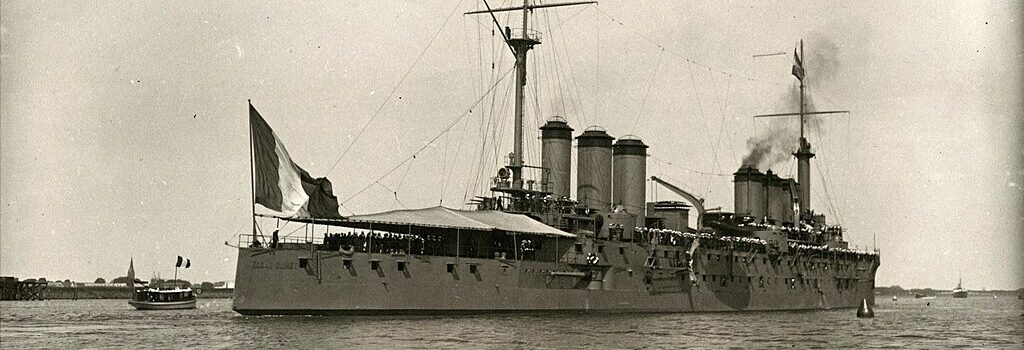
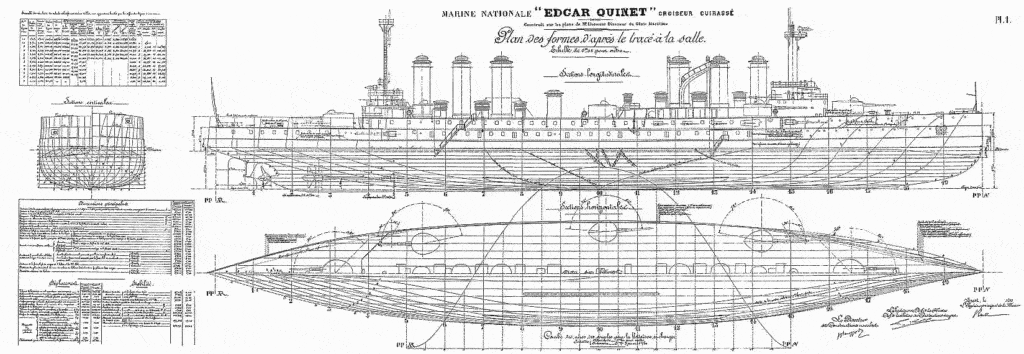
 Latest Facebook Entry -
Latest Facebook Entry -  X(Tweeter) Naval Encyclopedia's deck archive
X(Tweeter) Naval Encyclopedia's deck archive Instagram (@navalencyc)
Instagram (@navalencyc)





 French Navy
French Navy Royal Navy
Royal Navy Russian Navy
Russian Navy Armada Espanola
Armada Espanola Austrian Navy
Austrian Navy K.u.K. Kriegsmarine
K.u.K. Kriegsmarine Dansk Marine
Dansk Marine Nautiko Hellenon
Nautiko Hellenon Koninklije Marine 1870
Koninklije Marine 1870 Marinha do Brasil
Marinha do Brasil Osmanlı Donanması
Osmanlı Donanması Marina Do Peru
Marina Do Peru Marinha do Portugal
Marinha do Portugal Regia Marina 1870
Regia Marina 1870 Nihhon Kaigun 1870
Nihhon Kaigun 1870 Preußische Marine 1870
Preußische Marine 1870 Russkiy Flot 1870
Russkiy Flot 1870 Svenska marinen
Svenska marinen Søværnet
Søværnet Union Navy
Union Navy Confederate Navy
Confederate Navy Armada de Argentina
Armada de Argentina Imperial Chinese Navy
Imperial Chinese Navy Marinha do Portugal
Marinha do Portugal Mexico
Mexico Kaiserliche Marine
Kaiserliche Marine 1898 US Navy
1898 US Navy Sovietskiy Flot
Sovietskiy Flot Royal Canadian Navy
Royal Canadian Navy Royal Australian Navy
Royal Australian Navy RNZN Fleet
RNZN Fleet Chinese Navy 1937
Chinese Navy 1937 Kriegsmarine
Kriegsmarine Chilean Navy
Chilean Navy Danish Navy
Danish Navy Finnish Navy
Finnish Navy Hellenic Navy
Hellenic Navy Polish Navy
Polish Navy Romanian Navy
Romanian Navy Turkish Navy
Turkish Navy Royal Yugoslav Navy
Royal Yugoslav Navy Royal Thai Navy
Royal Thai Navy Minor Navies
Minor Navies Albania
Albania Austria
Austria Belgium
Belgium Columbia
Columbia Costa Rica
Costa Rica Cuba
Cuba Czechoslovakia
Czechoslovakia Dominican Republic
Dominican Republic Haiti
Haiti Hungary
Hungary Honduras
Honduras Estonia
Estonia Iceland
Iceland Eire
Eire Equador
Equador Iran
Iran Iraq
Iraq Latvia
Latvia Liberia
Liberia Lithuania
Lithuania Mandchukuo
Mandchukuo Morocco
Morocco Nicaragua
Nicaragua Persia
Persia San Salvador
San Salvador Sarawak
Sarawak Uruguay
Uruguay Venezuela
Venezuela Zanzibar
Zanzibar Warsaw Pact Navies
Warsaw Pact Navies Bulgaria
Bulgaria Hungary
Hungary

 Bundesmarine
Bundesmarine Dutch Navy
Dutch Navy Hellenic Navy
Hellenic Navy Marina Militare
Marina Militare Yugoslav Navy
Yugoslav Navy Chinese Navy
Chinese Navy Indian Navy
Indian Navy Indonesian Navy
Indonesian Navy JMSDF
JMSDF North Korean Navy
North Korean Navy Pakistani Navy
Pakistani Navy Philippines Navy
Philippines Navy ROKN
ROKN Rep. of Singapore Navy
Rep. of Singapore Navy Taiwanese Navy
Taiwanese Navy IDF Navy
IDF Navy Saudi Navy
Saudi Navy Royal New Zealand Navy
Royal New Zealand Navy Egyptian Navy
Egyptian Navy South African Navy
South African Navy






























 Ukrainian Navy
Ukrainian Navy dbodesign
dbodesign